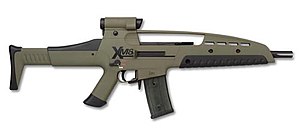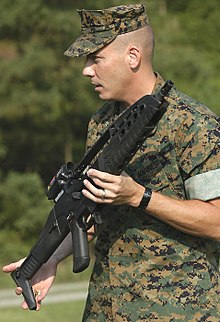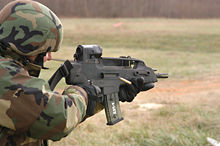HK XM8
| HK XM8 | |
|---|---|

|
|
| general information | |
| Military designation: | XM8 |
| Developer / Manufacturer: | Heckler |
| Development year: | 2002 |
| Manufacturer country: |
|
| Weapon Category: | Assault rifle |
| Furnishing | |
| Overall length: | 838 mm |
| Weight: (unloaded) | 2.659 kg |
| Barrel length : | 318 mm |
| Technical specifications | |
| Caliber : | 5.56 × 45 mm NATO |
| Possible magazine fillings : | 30, 100 cartridges |
| Ammunition supply : | Bar magazine , drum magazine |
| Cadence : | 750 rounds / min |
| Fire types: | Single , continuous fire |
| Visor : | Reflex sight |
| Closure : | Turret lock |
| Charging principle: | Gas pressure charger |
| Lists on the subject | |
The XM8 is an assault rifle from Heckler & Koch based on the HK G36 . The XM8 was developed after the OICW program was split into three parts, and was initially called OICW Increment I. Due to political concerns of those responsible for the project, the rifle was not procured.
history
After the consortium of ATK , HK and Brashear LP had prevailed in 1998 with its OICW design against the rival product from AAI , FN and Raytheon , development of the HK XM29 weapon began. Since the maximum weight of 6.35 kg for a loaded weapon could not be adhered to and the user expressed doubts about the effectiveness of the XM1018 grenade, the OICW program in 2004 was divided into three parts. OICW Increment I was supposed to introduce a modern assault rifle into the force (HK XM8) and OICW Increment II was supposed to produce an airburst grenade launcher ( HK XM25 ). The two components should then be brought together as OICW Increment III .
As a result, the OICW contract was modified and Heckler & Koch was commissioned to develop a family of weapons with a caliber of 5.56 × 45 mm . The family should consist of an assault rifle, a compact assault rifle, a light machine gun and a group sniper rifle . Heckler & Koch used the G36C as a development base, with the flat Picatinny rail on the weapon and a sight on the rear end. The forend was equipped with aluminum mounting rails on all four sides. The assault rifle had a longer barrel (comparable to G36K), which was partially covered by the housing extension. The shoulder rest of the G36 was adopted and an extendable variant was constructed as an alternative. A HK AG36 could be mounted under the barrel . Although the weapon was completed less than 120 days after the treaty was changed and it fully met the requirements of the US Army , it was rejected by the person in charge, James R. Moran, on the grounds that it looked too much like the German G36.
The HK team around Ernst Mauch then decided to keep the technology of the G36 as much as possible, but to have a new housing designed. In order to satisfy the high demands of the customer, the Uedelhoven Studio was commissioned, which creates among other things for Audi automobile designs. The design office created seven concepts, of which Moran chose the one known today. The XM8 was slightly modified, among other things, instead of the Picatinny rails, the Picatinny Combat Attachment Points (PCAP) were used as the mounting system, recognizable by the small holes in the fore-end. The new mounting system allowed a weight reduction of 1 lbs (0.45 kg) and a cost reduction of $ 300 per weapon. In addition to other small improvements to the weapon and visor, the technology of the G36 was retained.
As the US Special Operations Command (USSOCOM) the end of 2003 the order (for the special forces assault rifle SCAR English Special Operations Forces Combat Assault Rifle ) wrote out, competed alongside Heckler & Koch also FN . Both companies competed against each other in the OICW program. HK took part in the SCAR-L tender with an XM8. This weapon looked very similar to the original XM8 / G36 in that Picatinny rails were again required. As a consequence, the offer was rejected just five days after it was submitted. FN submitted the FN SCAR Mk16 / 17 and finally won unrivaled in 2004. The version in caliber 7.62 × 39 mm , which was still planned in the tender , was dropped and from 2010 the 5.56 mm version Mk-16 was no longer procured, so that FN was only able to sell a few SCARs. Remaining specimens were retired until 2013.
In 2005, the Army issued a formal RFP for the OICW Increment I family of weapons . Manufacturers were given six months to submit weapons with XM8-like performance requirements. A light machine gun with interchangeable barrels and a high sustained rate of fire should also be included. Since no manufacturer was able to meet the requirement to combine assault rifles and machine guns in a family concept, the RFP was frozen on July 19, 2005 for eight weeks. On October 31, 2005, OICW Increment I was deleted without comment. Despite an investment of $ 50 million since the start of the OICW program, the project has not been pursued. Since then, Heckler & Koch has been marketing a rifle similar to the AR-15 family under the designation HK416 and HK417 in parallel with the G36 .
A comparison test between the XM8, the HK416, the FN SCAR and the Colt M4 , which was organized by the US Army at the end of 2007, provided a small insight into the potential of the XM8 / G36 family . With ten weapons of each type under heavy desert conditions (Heavy Dust Test) 60,000 rounds were fired. While the M4 failed 882 times, HK416 and FN SCAR performed much better with 233 and 226 jams. The HK XM8 achieved the best result with only 127 jams. The Army then stated that the extreme conditions did not reflect the reliability in typical operational conditions.
technology
construction
(→ see also G36 / structure )
The weapon is a shooting, indirect gas pressure loader with a rotating head lock, whereby the repeating mechanism was derived from the Armalite AR-18 as in the G36 . The structure of the XM8 is almost exactly the same as that of the G36, so only the main differences between the two weapons are shown below:
The barrel holder is also made of steel and is baked into the plastic housing that is visible from the outside. In contrast to the G36, the weapon has no guide rails in the housing for the bolt carrier, this is guided through the housing walls made of fiber-reinforced plastic. The polygon barrel of the weapon is cold-hammered and chrome-plated on the inside for reasons of corrosion protection, the rifle length is 178 mm as with the G36. Since the bullet in the polygon barrel adapts better to the barrel profile due to the lack of sharp transitions between the fields and rifles, gas losses between bullet and barrel are significantly lower, which leads to a higher muzzle velocity compared to the G36 with the same barrel length. The Army target was that the barrel should withstand at least 20,000 rounds before it had to be replaced, with the gun reaching over 30,000 rounds. The barrel of the M4 / 16 is worn out after 7000 to 8000 shots. If on the G36 the bolt carrier automatically remains in the open position after a magazine has been fired empty, the bolt must be withdrawn after changing the magazine and released via the catch so that it snaps forward and the weapon is ready for use. With the XM8, this procedure has been shortened by installing a lever at the lower front end of the trigger guard, which can be pressed down with the extended index finger and then releases the bolt carrier. There is therefore no need to repeat the lock. The fire modes single shot, three-shot burst and fully automatic are available.
A weight reduction on components - especially those made of steel - and the new Picatinny Combat Attachment Points (PCAP) resulted in a significant weight reduction of the weapon. Another advantage of the PCAPs was that visors and other assembly components did not have to be readjusted after they were removed and attached. Although there were adapters to attach Picatinny rails to the PCAPs, variants were later developed that had Picatinny rails as standard. These were named the XM8-R. The first prototypes of the XM8 assault rifle weighed 6.4 pounds (2.88 kg) with a target weight of 5.7 pounds (2.56 kg).
Aiming aids
The assault, compact assault and machine gun versions were equipped with an Insight Tech-Gear ISM-IR reflex sight. The group sniper variant was equipped with an Advanced Magnified Optic (AMO) with four times magnification. This was based on the Tech-Gear ISM-IR, but had a built-in telescopic sight instead of the reflex sight. The rest of the features were identical.
Assemblies and accessories
Like most infantry weapons, the XM8 can be easily disassembled into its six assemblies - plus the sighting device, which can be removed using PCAPs. Some assemblies can in turn be dismantled into their individual components. Heckler & Koch combined the separate components of the handle, magazine holder and magazine well into a lower housing part, the handle was also fixed to the housing and the base was integrated into the shoulder rest with a closing spring:
- Housing with fixed handle, barrel and attachments
- Tube, gas drive (gas piston, drive rod), flash hider
- Hand protection
- Lower housing with handle, trigger group and magazine slot
- Bar magazine
- Shoulder rest or end plate with closing spring
- Clasp
- Bolt carrier, safety bolt, firing pin, control bolt, bolt head
- Sighting device
The XM8 can be equipped with further attachments. Apart from aiming aids, these are the XM320 mounted grenade launcher and the M26 Modular Accessory Shotgun System . The first models of the XM8 could still mount the HK AG36, later a separate version was developed, the XM320. As with the G36, the fore-end must be changed for attachment. Meanwhile the M320 is also suitable for Picatinny and stand-alone. In terms of performance, there is no difference to AG36; Like this one, it can fire modern 40 mm shells with extra length or medium velocity ammunition. The M26 is an underflow shotgun that is primarily used in house-to-house combat. Since the system was only envisaged, no forend with an integrated weapon was manufactured here.
Model variants
| variant | Total length mm |
Barrel length mm |
Height mm |
Width mm |
Weight kg |
Visor | Magazine (shot) |
|---|---|---|---|---|---|---|---|
| XM8 carbine | 838 | 318 | ≈320 | 64 | 2.7 | Tech-Gear ISM-IR |
Rod (30) drum (100) |
| XM8 Compact | 748 | 228 | ≈2.5 | ||||
| XM8 Automatic Rifle | 1028 | 508 | ≈3.4 | ||||
| XM8 Sharpshooter | 1028 | 508 | > 320 | ≈3 | Tech-Gear AMO | ||
Web links
Media reports from 2004 and 2008:
- Picatinny Arsenal: Strategy change speeds new assault rifle development (engl.)
- Feature by Richard Lardner about alternatives to the M4 (Engl.)
ArmyTimes videos on YouTube :
- XM8 Integrated Sighting Module
- XM320 Grenade Lancher
- XM8 Assembly and Disassembly
- XM8 Automatic Rifle Variant firing the 100 round drum magazin
Individual evidence
- ↑ Global security: XM29
- ↑ a b c d e Jim Schatz: The HK Decades. 2008 (PDF; 9.5 MB)
- ↑ Kitup.military.com: SCAR Mk-16 Reverb (To Buy or Not To Buy). July 9, 2010
- ↑ Mr. Patrick Carley: Ground Combatant Systems - Lethality, Visual Augmentation, Weapons, Ammunition. (PDF; 1.9 MB) (No longer available online.) Defense Technical Information Center, archived from the original on October 8, 2012 ; Retrieved February 15, 2013 .
- ↑ Jane's Defense Weekly, April 26, 2006 (Issue 43, p. 30)
- ↑ Article from December 19, 2007 on www.armytimes.com
- ↑ a b Shawn T. Jenkins, Douglas S. Lowrey: COMPARATIVE ANALYSIS OF CURRENT AND PLANNED SMALL ARMS WEAPON SYSTEMS. NAVAL POSTGRADUATE SCHOOL, 2004 ( Memento from April 11, 2016 in the Internet Archive ) (PDF; 1.3 MB)
- ↑ MAGPUL MASADA ™ ADAPTIVE COMBAT WEAPON SYSTEM
- ↑ a b c d e military.com: Wave of the Future: The XM-8 Battle Rifle. 2004
- ↑ Jim Schatz: Time for a Change. 2009 ( Memento from July 19, 2013 in the Internet Archive ) (PDF; 3.9 MB)
- ^ Military.com: XM-8: A Rifle Design for Today's Soldier. June 21, 2005



